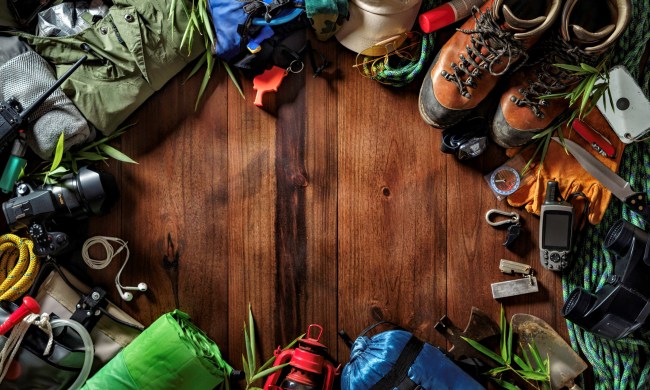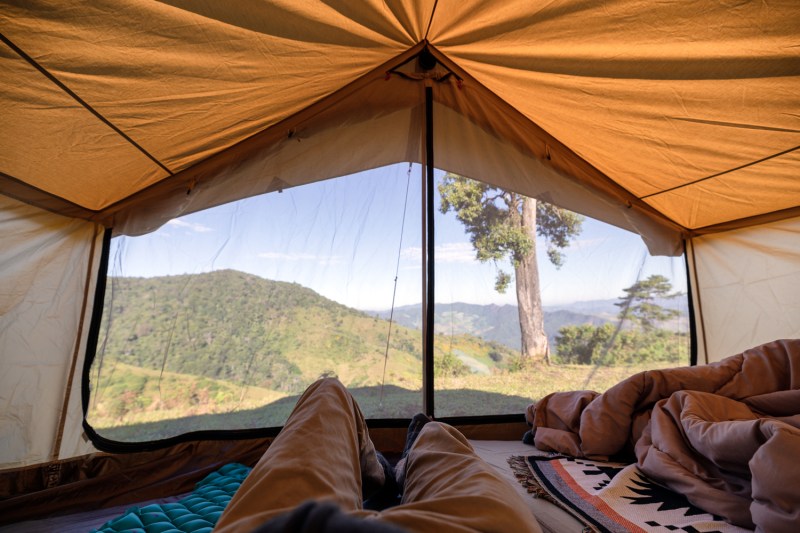
We all love the outdoors. Truly. And most of us want the most immersive experience we can handle every time we get out there to enjoy nature. Let’s be honest though … We’ve all got our limits. For some of us, it’s the thought of inhaling the spider crawling slowly across our faces as we sleep peacefully beneath the stars. Some of us don’t mind the bugs, but simply can’t handle the thought of getting our best sleeping bag or jacket ruined in the rain.
Whatever your mental hurdle, the solution is simple: You need one of the best tents money can buy for whatever sort of outdoor adventures you’re planning. We’ve rounded up the best advice we can muster on every kind of tent known to man, from superlight backpacking tents to backcountry mansions big enough for your entire extended family, their dogs, and a flatscreen TV. To top it off, we’ve got a few of our favorite picks for the best tents of 2021 in every category.
Related Guides
Camping Tents
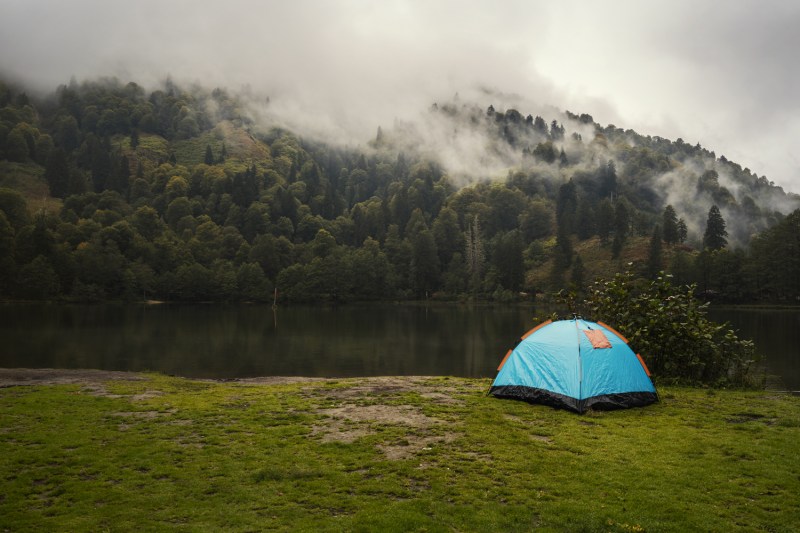
Camping tents are the ones we reach for when we’re car camping, beach camping, or doing any sort of overnight adventure that doesn’t require hiking in or out with our shelters. These versatile tents split the difference between the minimalist backpacking tent and the glamping behemoths that are group camping tents. Camping tents are typically made for groups of two to four people, although they may be rated for as many as six or eight sleepers.
Best Overall: REI Co-op Kingdom 6

We’ve got a lot of respect for REI’s in-house Co-op brand. Their gear is competitively priced, enthusiast-focused, and made from quality materials. The REI Co-op Kingdom 6 is no exception, and gets our vote for the best camping tent overall for its spacious interior, durable construction, and thoughtful design. Its cabin-style walls are almost completely vertical, rising to over six feet tall at the center of the tent. That means even taller campers can stand upright inside the Kingdom, which comes in handy for changing clothes, setting up sleeping arrangements, and easy egress in and out of the tent.
Speaking of egress, we’re also big fans of the REI Co-op Kingdom 6’s double door design. Coupled with the included room divider, it’s basically like having two separate tents in one. Each room has its own private entry and exit when you want it, or you can have one big tent with better airflow when you don’t. Materials are high quality and highly durable throughout. We especially like the large 75D polyester taffeta rainfly and sturdy hubbed aluminum pole set, which makes setup quick and easy, especially for such a large tent.
Read more: Best 4-Season Tents
Best for Budget: Kelty Rumpus 6
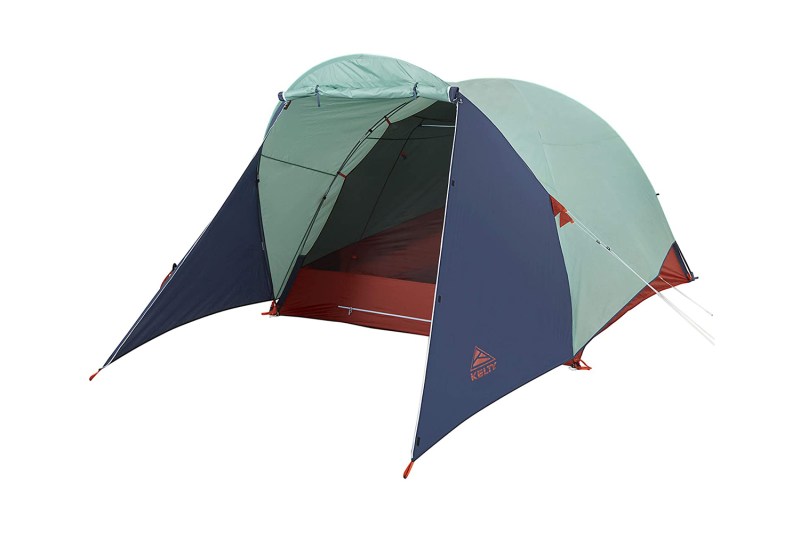
Kelty holds a unique space in the outdoor gear market for their consistently high-quality yet budget-friendly line of products. Their sleeping bags and internal frame packs are highly recommended for new backpackers on a budget, and their camping tents bring that same value to the table. The Kelty Rumpus comes in both four and six-person options, but we prefer the latter for its extra headroom. It’s also got a gigantic extended rainfly that doubles as a shady shelter from the sun or a waterproof storage room for your gear when the weather goes south.
It’s got the same amount of floor space as the premium Kingdom 6 camping tent above, and shares the same peak height as well (around 75 inches at its center), but trades in some of the Kingdom’s premium features for a simpler (and less expensive) approach. It’s a classic dome-style tent, so you won’t get the vertical walls of the Kingdom or the hubbed poles that make setup much quicker and easier.
The other main tradeoff is in materials, as the Rumpus uses slightly thinner 68D fabric and fiberglass poles to keep costs down. The tent fabrics are still super sturdy and the fiberglass poles are some of the thickest we’ve seen, but more expensive tents have a clear advantage here.
Read more: Best Waterproof Tents
What Are the Benefits of a Lightweight Camping Tent?
Imagine taking your old tent from scouts or summer camp and turning it into the kind of shelter an adult looks forward to sleeping in. What would you change? A ceiling tall enough to stand up in? A queen-sized bed? A second room for added privacy? A back door? A front porch?
Every single one of these is a potential benefit of the best camping tents. Tents like these are compact enough to throw in any trunk or backseat and take anywhere, but still offer a ton of the amenities and the added livability you’d get in a cabin.
What Should You Look For in a Camping Tent?
Although a lot of the usual technical considerations like weight and packed size don’t really apply to car camping tents, you should still keep some basics in mind when shopping for one: Durability, weatherproofing, and overall livability.
The best camping tents start with the best materials. Higher denier fabrics (like the 150D floor of our top pick below) are generally more durable than lower denier ones. The quality of the tent poles should be considered as well.
Generally speaking, alloy poles are the industry standard, and the best are made from brands you know like DAC, whose collapsible aluminum poles are some of the best in the business. Typically you want to avoid tent poles made from fiberglass, as they’re heavier and more likely to break under stress. If you’re shopping for a good tent on a budget, however, tents like the Kelty Rumpus below use super-thick wrapped fiberglass poles to help keep costs down while still giving you a sturdy and reliable frame.
Backpacking Tents

Minimalist, lightweight, and compact, backpacking tents are the weapon of choice for thru-hikers and weekend warriors alike, who carry their shelters with them deep into the wilderness. The best backpacking tents are a compromise of size, weight, durability, and features. The lighter and smaller you go, the more sparse and stripped down these tents become. Opt for a larger tent and you’ll have more room to stretch out, but you’ll feel the weight on your back out on the trail.
Best Overall: Big Agnes Copper Spur HV UL2
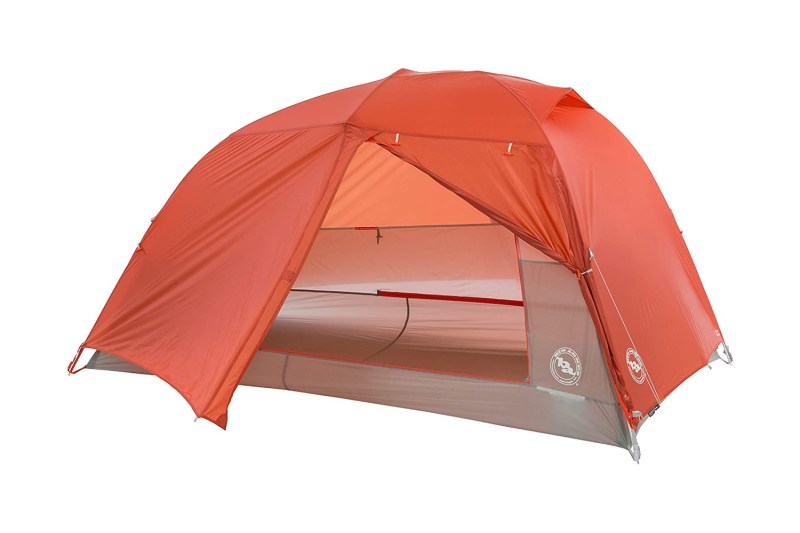
The Big Agnes Copper Spur HV UL2 tent is a darling of the backpacking world. No stranger on any number of “best tent” lists out there currently, the Copper Spur balances low weight, plentiful space, and premium materials like nothing else on the market. Despite its three-pound weight, this Big Agnes backpacking tent still manages to offer impressive headroom and almost 30 square feet of floor space. That translates to an incredibly roomy shelter for one, or a comfortable place to sleep for two.
The Copper Spur HV UL2 also gets bonus points for its double door/double vestibule design. If you’ve ever had your partner crawl over you to pee in the middle of the night, you know that second door is worth its weight in gold. As an added bonus, both vestibules separate and extend outward, and with the help of a couple of trekking poles convert into dual awnings for added livability in the backcountry.
Best Budget: REI Co-op Half Dome SL 2+ Tent With Footprint
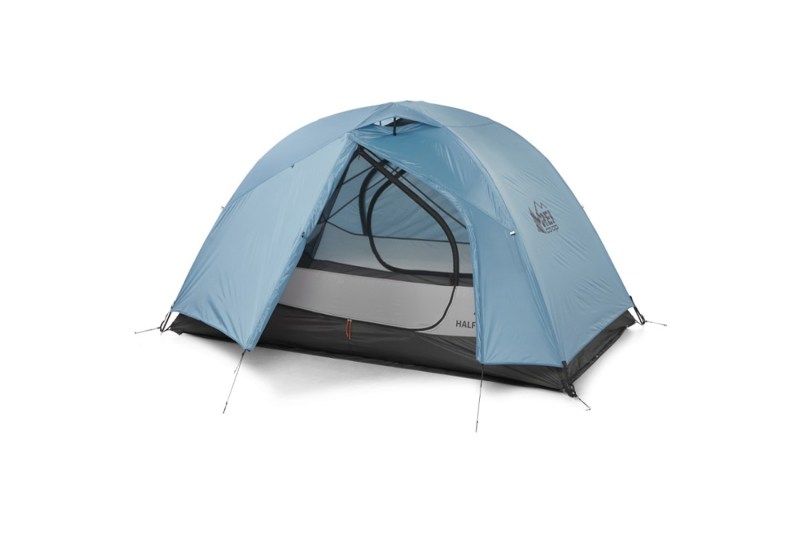
We can hear the superlight crowd scoffing at this one from here, but hear us out: The REI Co-op Half Dome SL2+ is one of the best bargains in backpacking. It’s got ample space inside for two backpackers plus their gear (hence the “2+” name), and includes value-added bonuses like a footprint, pole repair tube, and extra stakes and guy lines. Set up is fast and simple thanks to the high-quality DAC featherlite hubbed poleset, and the 40D nylon body and floor are a great compromise between weight and durability.
The glaring issue most backpackers will point out is the Half Dome’s four-pound eleven-ounce packaged weight, which is a full pound and a half heavier than the Big Agnes above. BUT! Disconnect the included footprint and leave your extra stakes at home, and you’ll shave the Half Dome down around four pounds even.
That’s not bad for a single hiker doing long miles and an absolute breeze for a hiking duo. Plus, when you get back from those extended backpacking trips, your extra accessories will be waiting for you, ready to turn the Half Dome SL2+ into a pretty cozy car camping tent with room to spare for a pup or two.
What Are the Advantages of Backpacking Tents?
The main advantages of a good backpacking tent are its compact size and low weight. Remember, these tents live in your backpack when they’re not in use, and have to share that space with your best camping cooking gear, sleeping bag, food, water, clothes, etc. With that being said, there are still several backpacking tents out there that work a surprising amount of creature comforts into their designs without tipping the scales.
How Should You Choose a Backpacking Tent?
Choosing the best backpacking tent for you comes down to a few factors: How much space do you need, how much weight are you willing to carry, and how much money you’re looking to spend. In the world of backpacking, there’s always a “latest and greatest” option out there that’s stronger and lighter than anything else available… If you’ve got the money to spend, that is.
For the rest of us, setting a budget and finding a happy medium between space, features, durability, and cost is a clear choice. We’ve got recommendations for both sides of the spectrum. Regardless of your budget, we recommend sticking with a two-person tent whether you’re hiking solo or with a partner.
Two-person tents are lightweight (especially if you’re splitting them with another hiker) and typically have a lot more features than minimalist single-person shelters. Of course, if you’re committed to keeping your pack as small and light as possible, we’ve got recommendations for those tents further down as well.
One-Person Tents

If you’re camping solo and like to keep it simple, a one-person tent is the ideal minimalist shelter for folks who aren’t quite ready to switch to a bivy or tarp-tent setup. One-person tents are super compact while still providing enough living space for a single camper to kick back and relax between long days on the trail. They pack down easily, fit into even the smallest packs, yet still provide the same degree of protection from the elements as shelters twice their size.
Best Overall: Big Agnes Copper Spur HV UL1

That’s right, Big Agnes gets our top pick again in the one-person category with their smaller sibling Copper Spur HC UL1 backpacking tent. It’s got all the same materials and features as the UL2 minus the second door (it’s still got the extending vestibule), but manages to shave the total weight down to as low as 2.2 pounds!
It still costs a pretty penny, especially for a one-person tent, but if you want the best of the best this is the clear choice for 99% of campers. Yes, there are lighter and more compact options out there, but they’re likely going to be either single-walled tents that don’t ventilate as well, or tarp tents with far fewer features for a lot more money.
Best Budget: Kelty Late Start 1
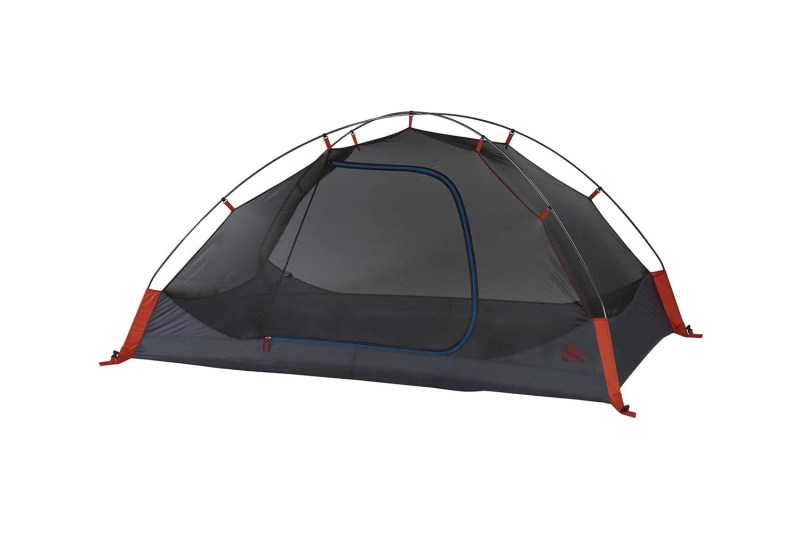
Another absolute banger from Kelty. If we’re being honest, we don’t know how this one-person tent can be this affordable. At about 3.5 pounds, the Late Start weighs less than some more “premium” tents on the market, but doesn’t skimp out on the premium features.
The Kelty Late Start 1 features an aluminum poleset (we’d expect fiberglass at this low price), a burly 68D polyester body, and a matching 68D rainfly for durable weather protection. It’s also super easy to set up thanks to its pre-bent pole design and Kelty’s “quick corners” attachment system that uses a clipless/pinless approach to securing the tent poles. We also love the pre-attached guy lines that live in their own “stash pockets” on the rainfly, which make them easier to find, harder to lose, and easier to stake out. Light. Simple. More than sufficient. Less than $150. What’s not to love?
What Are the Advantages of a One-Person Tent?
The single greatest advantage of a one-person tent is its size and weight. Many one-person tents weigh in at two pounds or less, and take up less space in your pack than a sleeping bag. As an added bonus, one-person tents also tend to be much less expensive than two-person tents, while still using the same quality materials as their larger siblings.
What Should You Look For in a One-Person Tent?
Just like the two-person backpacking tents described above, choosing a one-person tent will be a compromise driven largely by your budget, but you’ll have more options for the same amount of money considering these tents are lighter and less expensive by default.
A one-person tent is sort of a last stop before entering the world of super-minimalist tents and tarp tents, so we recommend taking full advantage of that fact and buying one with plenty of space to sit up, move around, get dressed, whatever. Remember, you’ll likely be spending a few long rainy nights marooned inside these tiny shelters. No need to make it anymore claustrophobic than necessary.
Bivy Sacks

Does sleeping in a tube on the ground sound like your idea of a good time? We’re not sure we can relate, but there are dozens (well, at least a dozen) of outdoors enthusiasts who share your love for sleeping inside of a weatherproof coffin directly on the forest floor. We’re kidding (sort of), but in all seriousness, a bivy sack is essentially a camping tent in its simplest form: A waterproof shelter built to keep you warm, dry, and bug-free in the outdoors.
Best Overall: Outdoor Research Helium Bivy

If we’re being honest here, Outdoor Research kind of has the market cornered if you’re shopping for a bivy as a dedicated tent substitute. Their Helium bivy is the first name in ultralight, full-featured bivy shelters, and has pretty much set the standard for all other bivvies to aspire to.
It uses a 100% stormproof Pertex 30D fabric up top that is as effective as GoreTex with serious durability to boot. A 40D TPU laminated floor handles the waterproofing and ground protection duties underneath, and is built to go the distance for week-long excursions and six-month thru-hikes alike.
Outdoor Research’s unmistakable Delrin single-pole system provides a surprising amount of space between your upper body and the bivy’s outer shell, to the point that the Helium bivy could be accused of blurring the lines between an emergency shelter and minimalist single-person tent.
Best Budget: SOL Emergency Bivy XL

Ok, you caught us, the SOL Emergency Bivy is absolutely not something you should plan on using as a regular shelter. What it is, however, is something every single camper should carry in their best DIY emergency kit, whether you’re a solo backpacker putting in long miles or a dayhiker with plans of coming home to a 12-person tent.
There’s a reason that a weatherproof shelter is part of the ten essentials of backpacking. You don’t ever want to be caught by surprise without one. That means even if you’ve got a tent pitched back at camp, you should have a waterproof shelter on your person while you’re out hiking. It might sound silly, but if you were to slip and break a bone during a short hike, you could find yourself spending an extra night in the woods you didn’t plan on.
The SOL Emergency Bivy fits in the palm of your hand, adds next to zero weight to your pack, and costs less than $30. It’s the least expensive, most important shelter on our list. Don’t go without one.
What Are the Advantages of Bivy Sacks?
Bivy sacks are about as “minimalist” as it gets in terms of shelters, and the best bivy sacks carry the kind of advantages you’d expect from the smallest “tent” money can buy. They’re the lightest, most compact, and most basic shelters out there. They take up next to no space in your pack, typically weigh about one pound altogether, and have the least complicated setup/tear-down procedure known to man.
Bivy sacks are also the preferred shelter when sleeping space is at a premium. Big wall climbers, for instance, often carry a bivy if they’re planning on spending the night on whatever flat space they can find on the way up a multi-day climb.
What Should You Look For in a Bivy Sack?
Because your bivy will be the only thing between you, your gear, and the elements, it’s important to have the best waterproofing you can reasonably afford. GoreTex is still the gold standard in the outdoors industry for breathable waterproof protection, but there are a few other proprietary waterproofing systems out there that give GoreTex a run for its money.
The second important consideration is headroom. Obviously, if you’re considering a bivy sack in place of even the best tent out there, you’re committed to the minimalist mindset. With that being said, no one will be handing out medals at the end of your trip to the person who had the least enjoyable experience overall.
Bivy sacks with an added loop or “clamshell” at the entrance to the shelter (where your head goes) give precious inches of space between your face and the impact of falling raindrops. It’s an added degree of livability with essentially no space or weight penalty, and doubles as a space you can comfortably prop up on your elbows for nighttime reading or chatting with a friend across camp.
Group Camping Tents

Dream of one day getting away from it all and escaping to a quiet, three-bedroom apartment in the mountains? Apparently, you’re not alone, because these massive 12-person backcountry mansions have been selling like hotcakes all year.
Ok, to be fair, most folks call them “instant cabins” but the best group camping tents all seem to share the same formula: Vertical walls, multiple rooms, and enough floor space to cartwheel between them (or fit three queen-sized mattresses, whichever you prefer).
Read More: Most Extravagant and Expensive Tents in the World
Best Overall: Ozark Trail Instant Cabin

No, the Ozark Trail name isn’t exactly synonymous with enthusiast camping gear but let’s be honest: This is group camping. We’re just here to hang out and hopefully enjoy a decent night’s sleep at the end of the day. The Ozark Trail absolutely delivers on the hangs. We like its unique “L-shaped” design, which wraps three rooms around a shared awning that doubles as rain protection for the double doors and any shoes/gear/friends you leave outside.
Each of those three rooms has its own divider/privacy wall, so you can change clothes or get weird from each of the 85 square-foot rooms without any fear of prying eyes. Ozark Trail advertises the Instant Cabin as a “two-minute” setup thanks to its hubbed/hinged pre-attached pole layout. We find that a little optimistic, taking the large rainfly and multiple guy lines into account, but you could absolutely get the tent standing inside that time limit with a single person. And, as with all Ozark Trail products, the price is tough to beat. Three rooms, a ton of features, room to sleep up to twelve, AND a party porch for under $500? Sign us up.
Read more: Best 4-Person Tents
What Are the Advantages of a Group Camping Tent?
These are the biggest of the big. The kings and queens of tents. Basically a pop-up house you can toss in the trunk of your car. Because size and weight are no longer even remotely a concern, group camping tents have the advantage of focusing entirely on creature comforts and livability. Go to bed on a double-thick queen-sized mattress, wake up in the morning, and have a nice standing stretch. Call the kids and dog in from the other room when it’s time for breakfast. It’s basically living at home, but with polyester walls and no plumbing.
What Should You Look for in a Group Camping Tent?
There are some special considerations to take into account when shopping for a tent this large. First should be the set-up (and takedown) process, since you can’t really enjoy a tent until it’s standing.
Believe it or not, many of these juggernauts are made to be set up by a single person thanks to pre-attached tent poles that run through hinged hubs. Just lay the tent out, lock the roof into place one pole at a time, then raise the tent using the telescoping support poles. Some of the tents in this genre can actually be set up faster than your average backpacking tent. Anything is possible when the only limit is your imagination. Air conditioning, for example, is a common add-on for group camping tents. Ahh yes … roughing it.

